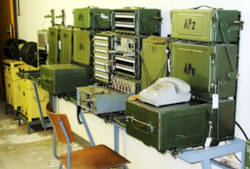Stasi-Bunker Machern
Useful Information
| Location: |
Naherholungsgebiet Lübschützer Teiche, Flurstück 439, 04827 Machern.
(51.380060, 12.644719) |
| Open: |
All year last weekend of the month, Sat, Sun 13-16. [2025] |
| Fee: |
Adults EUR 7, School Pupils EUR 5, Students EUR 5. [2025] |
| Classification: |
 Secret Bunker Secret Bunker
|
| Light: |
 Incandescent Incandescent
|
| Dimension: | Ar=1435 m². |
| Guided tours: | |
| Photography: | allowed |
| Accessibility: | |
| Bibliography: | |
| Address: |
Bürgerkomitee Leipzig e.V., PF 10 03 45, D-04003 Leipzig, Tel: +49-341-961-24-43.
E-mail: |
| As far as we know this information was accurate when it was published (see years in brackets), but may have changed since then. Please check rates and details directly with the companies in question if you need more recent info. |
|
History
| 1968 | Start of construction of the bunker. |
| 1972 | Bunker completed. |
| 1974 | The facility is handed over but has construction defects. |
| 1979 | Official handover after all construction defects have been rectified. |
| DEC-1989 | Discovered by the local priest in Machern immediately after the end of the GDR. |
| 1996 | opened as a museum. |
Description

The Stasi-Bunker Machern is officially named Museum im Stasi-Bunker (Museum in the Stasi Bunker) and is managed by the Verein Bürgerkomitee Leipzig e.V. (Leipzig Citizens' Committee Association) for the Dissolution of the Former State Security Service (MfS). It is located north of the Lübschützer Teiche forest garden settlement in the north of Machern. The bunker was the Ausweichführungsstelle (AFüSt, alternative command centre) of the Leipzig District Administration for State Security (BVfS). At the time, the Lübschützer Teiche recreational area was disguised as a holiday resort belonging to the VEB Wasserversorgung und Abwasserbehandlung Leipzig (Leipzig Water Supply and Wastewater Treatment Company). In the event of a so-called "state of tension and mobilisation", 120 full-time Stasi employees and two KGB liaison officers from the district administration would have been transferred here.
During the Cold War, such bunkers were parts of the administration could continue their work during a war existed on both sides. However, the Stasi only existed in the GDR, so special bunkers for the State Security Service existed only here. The MfS had such a bunker in every district, as all district administrations had received the same order from Erich Mielke. There were therefore 15 Stasi bunkers in the GDR, from which the SED power apparatus would have been maintained in a crisis situation. In other words, these bunkers had no military or civil defence purpose whatsoever; they served exclusively for internal security. The bunker in Machern is the only facility of this type that has been almost completely preserved.
The bunker contains a museum about the military activities of the MfS and its tasks in the event of so-called "Spannungs- und Mobilmachungsfall" (lit: tension and mobilisation). Guided tours explain the technical infrastructure and strategies for protection against radiation in the event of a nuclear attack. However, the duration of the protective effect seems to be relatively short. While 3 to 4 weeks of self-sufficiency were usual, times between 12 hours and 14 days are specified here. A telephone line to Leipzig and a radio transmitter outside the bunker enabled communication. The construction costs are unknown but are estimated to be in the high seven-figure range.
 Search DuckDuckGo for "Stasi-Bunker Machern"
Search DuckDuckGo for "Stasi-Bunker Machern" Google Earth Placemark
Google Earth Placemark OpenStreetMap
OpenStreetMap Stasi Bunker Museum, official website (visited: 01-NOV-2025)
Stasi Bunker Museum, official website (visited: 01-NOV-2025) (visited: 01-NOV-2025)
(visited: 01-NOV-2025) Index
Index Topics
Topics Hierarchical
Hierarchical Countries
Countries Maps
Maps